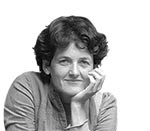Isabella Tree on her great-grandmother in-law
Isabella’s husband’s great grandmother was a fierce advocate for women all over the world


On Tuesday, March 12, Australia will celebrate the day, a century ago, when the wife of the Governor-General mounted a dais in New South Wales to name Australia's new capital. In 1913, the vice-regal party had spent the night in tents in the bush, there being no new capital to speak of as yet. The Governor-General, Lord Denman, had laid the foundation stone that morning.
The name of the new capital had been the subject of heated debate. To avoid further controversy, the cabinet had decided to keep the name they had chosen secret, revealing it as a fait accompli at the official ceremony. Lady Denman herself had no idea what was written on the card handed to her inside a gold cigarette case. It was also decided that however she said it would be the official pronunciation. She must have been praying they hadn't gone down the route of Imeerawanyee or Woolloomooloo.
My husband's great-grandmother wasn't a looker, but, at 28 years old, in her Belle Epoque Edwardian dress, kid gloves and feathered hat, she cut an elegant figure. Beside her, in the photograph we have of the great day, Lord Denman is resplendent in cocked hat and tail coat festooned with epaulettes and aiguillettes a dress uniform that's been stored in japanned tin cases in our attic for years, now dusted off and sent to Australia for the commemorative exhibition. The Mameluke dress sword he wore, which usually lies on the hall table sparking the fantasies of every small boy that passes it, has also been despatched down under.
The Denmans' posting in Aus-tralia lasted barely three years, Lord Denman having been overwhelmed by hay fever induced by Australia's national flower, the wattle. But the constitution of his wife, Trudy, was more robust. When she wasn't shooting kangaroos from horseback (she was always anxious she might shoot off her horse's ears) and shark-fishing (she dispatched one in her boat with a pistol), she had been setting up nursing centres in the remotest parts of the Outback.
Trudy's experiences among poor, rural women in Australia triggered a sympathy that was to change the face of Britain. She became a passionate campaigner for sexual equality, turning the fledgling British Women's Institute (WI)-a movement she led for 30 years-into a nationwide ‘force for the good'. She saw the lot of women in Britain's villages as ‘the hardest of all', the WI as a vehicle to expand women's horizons in the countryside, to give them education and economic support and to free poorer women from domination not only by their husbands, but by the better-off squires' and parsons' wives.
She campaigned for piped water to rural homes, cheap electricity, telephone boxes in villages, the secret ballot for parish councils, the preservation of the beauty of the countryside and its ancient buildings and wildflowers, and for its protection against litter. In 1930, with her friend Margaret Pyke, she set up the Family Planning Association in an effort to stop women ‘having ten children before the age of thirty and dying in bad health'. Family legend has it that she changed the name from the National Birth Control Association to save the blushes of her butler.
The Second World War saw her founding the Women's Land Army, which, at its peak in 1943, employed 80,000 land girls working the fields to keep Britain from starvation. Our family albums are full of photographs of young women striding through the snow with lambs under their arms, felling trees and driving tractors.
Sign up for the Country Life Newsletter
Exquisite houses, the beauty of Nature, and how to get the most from your life, straight to your inbox.
It's that indomitable, country-loving, pioneering, feminist spirit I'll be thinking of on Tuesday when my stepmother-in-law and brother-in-law head off to the Australian capital from their home in Sydney to represent her, standing on the same spot from which Trudy Denman declared, in her plummy English accent, that, henceforth, the capital of Australia shall be called ‘Canbra'.
* Subscribe to Country Life and save
* Follow Country Life magazine on Twitter
Country Life is unlike any other magazine: the only glossy weekly on the newsstand and the only magazine that has been guest-edited by HRH The King not once, but twice. It is a celebration of modern rural life and all its diverse joys and pleasures — that was first published in Queen Victoria's Diamond Jubilee year. Our eclectic mixture of witty and informative content — from the most up-to-date property news and commentary and a coveted glimpse inside some of the UK's best houses and gardens, to gardening, the arts and interior design, written by experts in their field — still cannot be found in print or online, anywhere else.
-
 About time: The fastest and slowest moving housing markets revealed
About time: The fastest and slowest moving housing markets revealedNew research by Zoopla has shown where it's easy to sell and where it will take quite a while to find a buyer.
By Annabel Dixon
-
 Betty is the first dog to scale all of Scotland’s hundreds of mountains and hills
Betty is the first dog to scale all of Scotland’s hundreds of mountains and hillsFewer than 100 people have ever completed Betty's ‘full house’ of Scottish summits — and she was fuelled by more than 800 hard boiled eggs.
By Annunciata Elwes